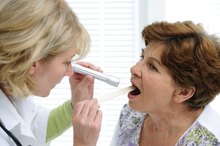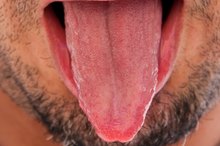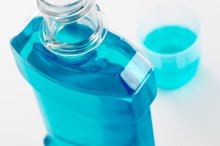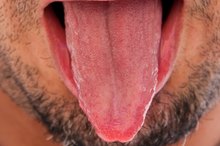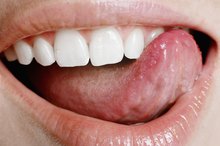Small, White Bumps on the Tip of the Tongue
Your tongue is essential for various functions, including speaking, eating and tasting. It is made of 8 strong muscles located within a dark pink covering known as the mucosa.
The top surface of the tongue is covered with small pink bumps called papillae, which extend up from the mucosa.
Sometimes these papillae become inflamed, producing white bumps called lie bumps. At other times, small white bumps on the tip of the tongue are caused by other conditions, such as canker sores or thrush.
Lie Bumps
Lie bumps occur when tongue papillae, especially those at the front of the tongue, become inflamed. **This condition, also known as transient lingual papillitis, occurs in about 50 percent of people at some time in their life, according to an article published in the January 2017 issue of “Journal of Clinical and Experimental Dentistry. **”
When inflamed, the papillae become swollen, producing pink, yellow or white bumps. Lie bumps generally cause pain or a tingling or itchy sensation. One or more bumps may be present.
The cause of lie bumps is unknown and may differ from person to person. Viruses, repeated trauma to the tongue due to repeated rubbing against sharp edges of teeth or braces, stress, insufficient sleep, smoking, alcohol and food allergies are among the many factors that may play a role.
Lie bumps are not contagious, except for a specific type called eruptive lingual papillitis with household transmission 2. Lie bumps resolve on their own but may reappear in the future.
- Lie bumps occur when tongue papillae, especially those at the front of the tongue, become inflamed.
- The cause of lie bumps is unknown and may differ from person to person.
Canker Sores
Diseases and Disorders of the Tongue
Learn More
Canker sores are whitish bumps in the mouth, which often occur on the tip of the tongue. Approximately 20 to 30 percent of adults experience canker sores, according to Merck Manual 35.
Also called aphthous ulcers, canker sores appear as a small red ring with a whitish center. **Pain or burning may occur for 1 to 2 days before the canker sore becomes visible.
Cankers can be very painful because the central area is an open sore. ** They usually appear as one or just a few bumps.
It is unknown what causes canker sores, but they tend to run in families. Trauma and stress may also contribute to their development. Allergies and viruses do not appear to be involved.
Canker sores are not contagious. They resolve on their own, but many people with canker sores have repeated episodes over their lifetime.
- Canker sores are whitish bumps in the mouth, which often occur on the tip of the tongue.
- Pain or burning may occur for 1 to 2 days before the canker sore becomes visible.
Thrush
Oral thrush may cause white bumps anywhere in the mouth, including the tip of the tongue. Thrush may appear as single or multiple bumps. The bumps begin as small whitish areas but can grow to form large patches. Initially symptoms may be minimal, but bleeding and pain occur when thrush is scraped away from the underlying tissue.
Oral thrush is an infection caused by overgrowth of a fungus called Candida albicans. Most people have a small amount of this fungus in their mouth, but it usually remains in check until certain conditions — such as an acute illness or a weakened immune system — allow excessive growth.
People with diabetes are also prone to oral thrush as high levels of sugar in their saliva promote fungus overgrowth.
Thrush is not contagious.
It sometimes resolves on its own, especially in people with a normal immune system. Thrush may recur in the future.
- Oral thrush may cause white bumps anywhere in the mouth, including the tip of the tongue.
- Initially symptoms may be minimal, but bleeding and pain occur when thrush is scraped away from the underlying tissue.
Treatment
Pimple-Like Bumps on the Tongue
Learn More
Lie bumps and canker sores usually resolve on their own in a few days but may last up to a couple weeks.
Treatment generally does not speed up recovery but can be useful to reduce pain. Cold drinks and rinsing with salt water may provide temporary pain relief.
Nonsteroidal anti-inflammatory drugs, such as ibuprofen (Advil, Motrin) or naproxen (Aleve), may help decrease pain.
Topical over-the-counter or prescription medications containing local anesthetics, corticosteroids or antiseptics may also be helpful. Foods, drinks or dental products that worsen pain should be avoided.
Oral thrush often requires treatment with anti-fungal medications, such as nystatin or clotrimazole. Mouthwashes containing an antifungal medicine may be adequate, but pills taken by mouth are sometimes needed.
- Lie bumps and canker sores usually resolve on their own in a few days but may last up to a couple weeks.
- Mouthwashes containing an antifungal medicine may be adequate, but pills taken by mouth are sometimes needed.
Seeking Medical Attention
See your doctor if you have repeated episodes of tongue bumps or if you have bumps that are severe enough to interfere with eating or drinking. Also visit your doctor if you notice white tongue bumps and have a weakened immune system, as this increases your susceptibility to oral thrush requiring treatment.
If you have any new bump on your tongue that persists for more than a couple weeks, see your doctor to make sure it is not cancer. In its early stages, tongue cancer may be white or reddish and often produces no pain or other symptoms.
Reviewed and revised by Mary D. Daley, M.D.
- See your doctor if you have repeated episodes of tongue bumps or if you have bumps that are severe enough to interfere with eating or drinking.
- Also visit your doctor if you notice white tongue bumps and have a weakened immune system, as this increases your susceptibility to oral thrush requiring treatment.
Related Articles
References
- DermNet NZ: Transient Lingual Papillitis
- Merck Manual Professional Version: Recurrent Aphthous Stomatitis
- Journal of Clinical and Experimental Dentistry: Transient Lingual Papillitis -- A Retrospective Study of 11 Cases and Review of the Literature
- Merck Manual Professional Version: Candidiasis
- Anatomy and Physiology, Volume 2 of 3; J. Gordon Betts, et al.
- Merck Manual Consumer Version: Tongue Sores and Bumps
- Kalogirou EM, Tosios Kl, Nikitakis NG, Kamperos G, Sklavounou A. Transient lingual papillitis: A retrospective study of 11 cases and review of the literature. Clin Exp Dent. 2017;9(1):e157-e162. doi:10.4317/jced.53283
- Mondal A, Kumar P. Eruptive lingual papillitis. Indian Pediatr. 2014;51(3):243.
- Dyall-Smith. Transient lingual papillitis. DermNet NZ. 2010.
- Raji K, Ranario J, Ogunmakin K. Goodness, gracious, great balls of fire: A case of transient lingual papillitis following consumption of an Atomic Fireball. Dermatol Online J. 2016;22(5).
- Bouquot JE, Adibi SS, Sanchez M. Chronic lingual papulosis: new, independent entity or "mature" form of transient lingual papillitis? Oral Surg Oral Med Oral Pathol Oral Radiol. 2012 Jan;113(1):111-7. doi: 10.1016/j.tripleo.2011.09.003
- Nigri AP, et al. Transient lingual papillitis related to food allergy. Oral Surgery, Oral Medicine, Oral Pathology and Oral Radiology, 2014;117(2)e193. doi:10.1016/j.oooo.2013.12.228
Writer Bio
Meg Brannagan has worked as a registered nurse for more than 10 years, specializing in women's and children's health. She holds a bachelor's degree in nursing from the University of Nebraska Medical Center.

